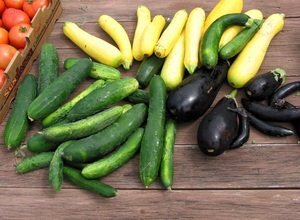One of the experiences that guests at Holy Wisdom Monastery consistently enjoy is sharing a meal with the sisters and other guests. As one personal retreatant put it, “My meal was perfect. I had forgotten how colorful and good tasting real food is. Dining room lovely to be in and I enjoyed meeting all of you!”
Balanced meals are very important in the Rule of Benedict. The Rule reads: “Whether the main meal each day is at noon or in mid-afternoon, two cooked dishes on every table should be enough to allow for differences of taste, so that those who feel unable to eat from one may be satisfied with the other” (Rule of Benedict 39). The sisters use what is in season, even if it means eating tomatoes at two meals in the same day. This is what God provides at certain times in the year, and the sisters are grateful for what is given. They also freeze items for use later in the year and donate a fair amount of fresh produce to Middleton Outreach Ministry, a local food pantry and Luke House, a community meal program in Madison.
 Most of the food served at Holy Wisdom Monastery, especially during the summer months, is fresh from the sisters’ vegetable gardens, which are about a half acre in size and yield hundreds of pounds of fresh produce each year. This year the sisters grew pea pods, green beans, wax beans, beets, red and green cabbage, several types of lettuce, spinach, kale, Swiss chard, tomatoes, potatoes, golden and fingerling onions, okra, corn, cucumbers, carrots, zucchini, eggplant, green and banana peppers, squash, asparagus, horseradish, rhubarb, chives, thyme and dill. According to Lynne Smith, OSB, “the green beans were prolific this year!”
Most of the food served at Holy Wisdom Monastery, especially during the summer months, is fresh from the sisters’ vegetable gardens, which are about a half acre in size and yield hundreds of pounds of fresh produce each year. This year the sisters grew pea pods, green beans, wax beans, beets, red and green cabbage, several types of lettuce, spinach, kale, Swiss chard, tomatoes, potatoes, golden and fingerling onions, okra, corn, cucumbers, carrots, zucchini, eggplant, green and banana peppers, squash, asparagus, horseradish, rhubarb, chives, thyme and dill. According to Lynne Smith, OSB, “the green beans were prolific this year!”
During the autumn, guests also enjoy cider that is pressed from the two apple orchards. Over 200 bushels of apples are expected from these orchards in 2011, with 81 bushels just harvested on Community Workday on September 24, 2011.
The sisters themselves work several hours a week in the garden as part of Benedict’s call to do manual labor. The Rule of Benedict states: “It may be, of course, that because of local conditions or the poverty of the monastery, the members of the community may themselves have to do the harvest work. If that happens, it should not discourage anyone because they will really be in the best monastic tradition if the community is supported by the work of its own hands. It is just what our predecessors did, and the apostles themselves. Nevertheless, there must always be moderation in whatever such demands are made on the community out of consideration for those who are not strong.” In addition to the sisters, our groundskeeper and many volunteers including the Volunteers in Community spend hours helping in the gardens as well.
Inside the ‘green’ monastery building, the plant and produce room on the lower level, is designed for cleaning and storing the fresh harvest. At this time of year, the scent of fragrant apples wafts from this room, which is located just inside the back entrance to the monastery, closest to the gardens and orchards.
Once the produce is cleaned, it is sent to the kitchen on the upper level of the monastery to be made into delicious meals for the sisters and guests at Holy Wisdom Monastery. Chef Dana Hoffman has cooked at the monastery for the past two years. She especially appreciates the fresh vegetables used here, and observes the difference between a veggie picked in the morning from the garden compared to a vegetable from the organic section of the local grocery store. When large groups have meetings or events at Holy Wisdom Monastery a caterer is used to cook the meals.

